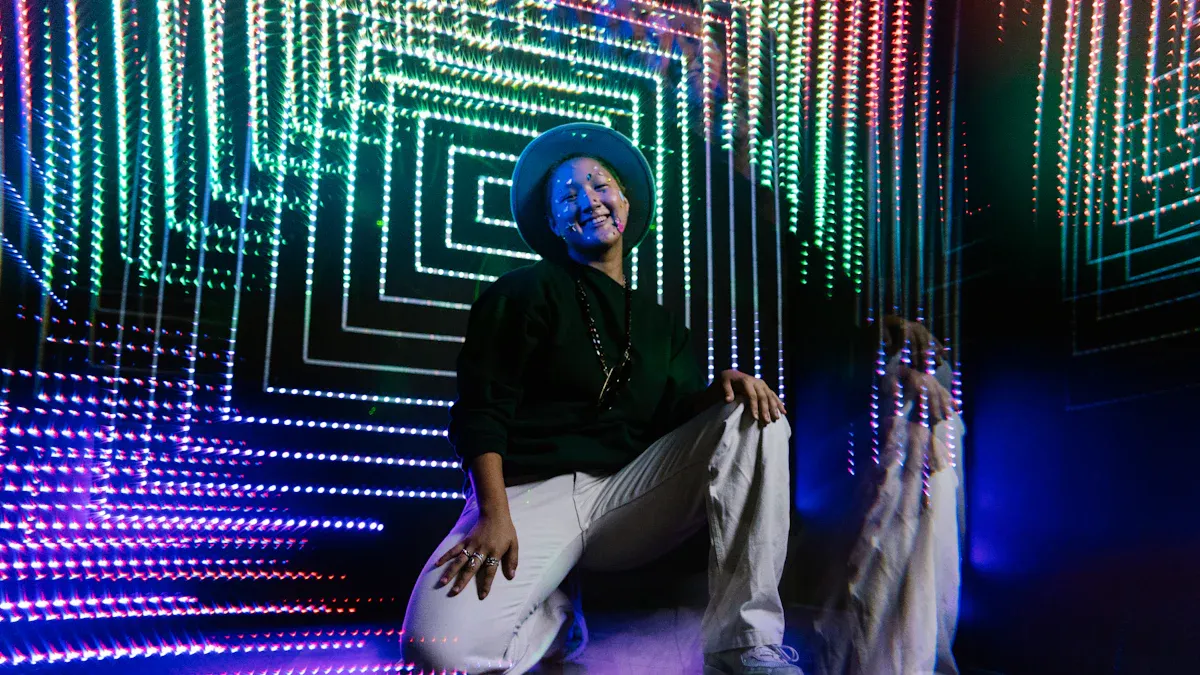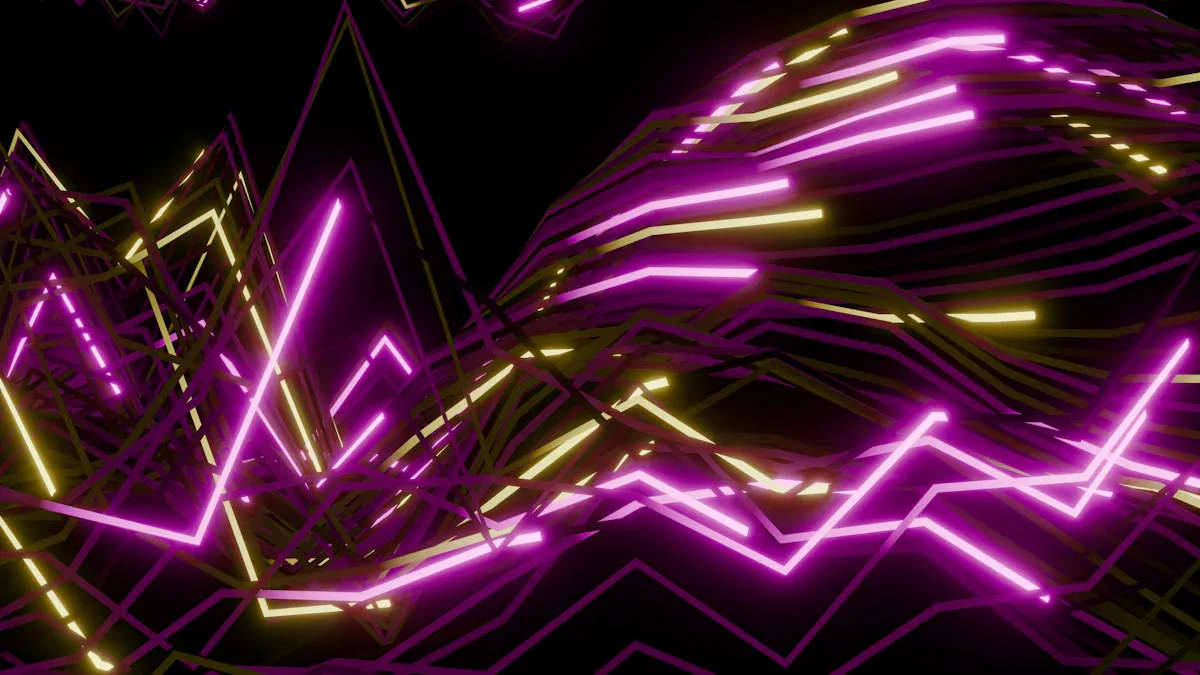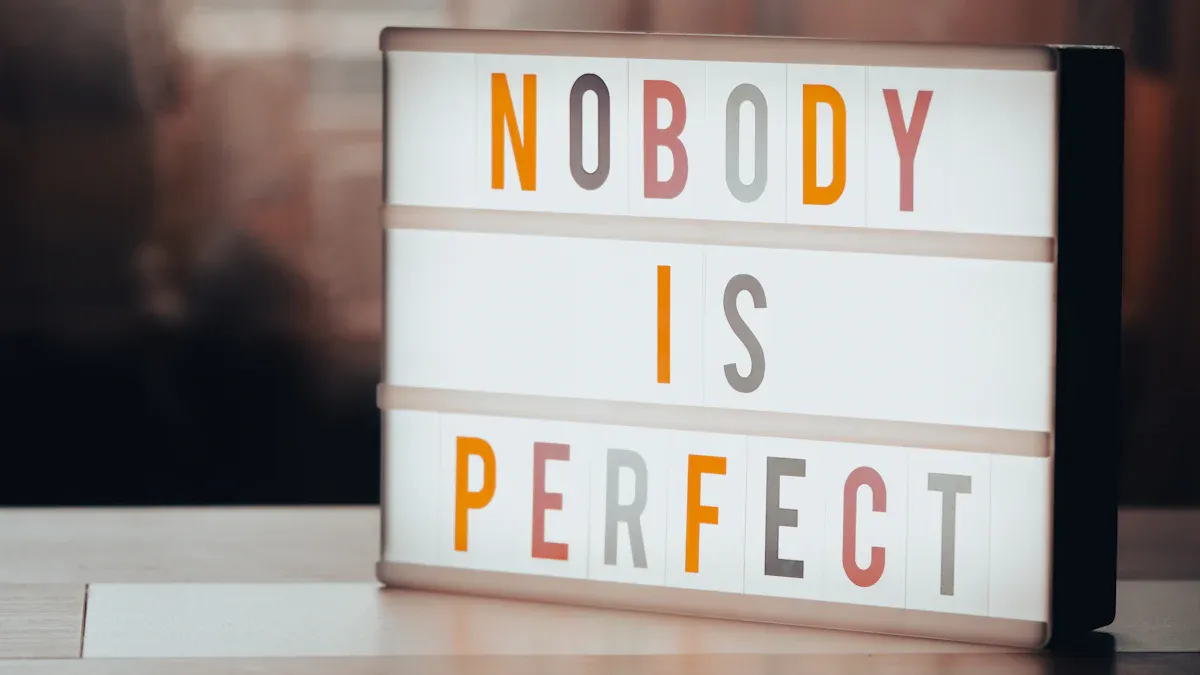5 Professional Artists Who Revolutionized Their Work Using LED Light Boxes

When you step into a gallery and see art that glows, you might feel like the room itself is alive. Light art has changed how you experience creativity. Professional artists use light to create powerful displays that grab your attention and spark your imagination. Light artists shape spaces and moods, making you see the world in new ways. These artists show you that light can become more than just a tool—it becomes the art.
Key Takeaways
Light art changes how you see creativity. It helps you feel like you are inside the art, not just looking at it.
LED light boxes show brighter colors and clearer details. They use less energy and help the environment.
Artists like Dan Flavin and James Turrell changed how people use light in art. Their art gives ideas to new artists.
You can make your own light art at home with easy materials. Try using different colors and shapes to watch how light changes your art.
Seeing light art in person can feel magical. Take your time and look at how light works with the space.
Light Art and LED Innovation

Transforming Art with Light
You might notice how light art grabs your attention the moment you walk into a room. This movement lets you see art in a new way. Instead of just looking at a painting or sculpture, you experience the glow and energy that light brings. Artists use light to create installations that change how you feel and think. You see colors shift, shadows move, and spaces transform right before your eyes. Light installations can turn a simple wall into a living canvas. When you explore these works, you become part of the art itself.
Light art has grown quickly in recent years. You see more artists using LED light boxes to push their creativity. These tools help them shape light in ways that were impossible before. The movement has inspired many artists to experiment with new materials and techniques. You get to enjoy art that feels modern, fresh, and full of life.
Did you know? Some light installations use smart technology to let you control the brightness or color. You can interact with the art and make it your own.
Why LED Light Boxes Matter
LED light boxes have changed the way artists create and display their work. You see brighter colors and sharper details because LEDs use less power but give more light. Traditional bulbs might use up to 60 watts, but an LED can do the same job with only 10 watts. This means lower energy bills and less impact on the environment.
The slim design of LED light boxes also makes art look sleek and modern. You notice how galleries and stores use them to highlight visual displays and branding. Artists love the flexibility these boxes offer. They can adjust the light to fit their vision and even connect the installation to smart home systems. You get to see art that feels alive and interactive.
LED light boxes help artists save money over time. Even if the initial cost is higher, the energy savings add up. You see more creative uses in galleries, retail spaces, and homes. This innovation sets the stage for the five artists who have taken light art to the next level. Get ready to discover how they use light to transform their work and inspire others.
Dan Flavin – Pioneer of Light Art
Artist Background
You may wonder how someone makes everyday things seem magical. Dan Flavin did this with his art. He first used regular materials. Later, he chose fluorescent light as his main medium. Here are some facts about his early work:
Flavin made eight icons using bulbs and short fluorescent tubes. This was his first time using light in art.
He liked using normal fluorescent lights, not custom neon. He wanted his art to look simple and real.
Flavin built his art with a system. He called it a "structured whole." You could swap out any part.
He took things you see in stores and offices and made them into art that feels alive. His style helped start object-based light sculpture.
Light Installations
When you enter a room with Flavin’s art, you see the glow right away. He set up fluorescent lights to change the space around you. The colors and shapes make a visual experience. It feels both moving and calm. You might feel like you are inside the art, not just looking at it.
Some people think his art looks like simple light fixtures. Others see beauty and joy in the bright tubes. Here is what critics have said:
Source | Type of Review | Summary |
|---|---|---|
The Guardian | Critical | Some say Flavin’s art is just light fixtures, not real art. |
Observer | Positive | Laura Cumming finds beauty and happiness in his use of fluorescent tubes. |
artistsandmakers.com | Dissenting | One critic says the show looks like a lighting store and questions if it is art. |
Impact on Art
You can see how Flavin changed how artists think about light art. He went past the rules of Minimalism. He explored how light works with space and people. His art inspired the light and space movement. He influenced artists like James Turrell and Olafur Eliasson.
Flavin’s work with light and space helped shape kinetic art and object-based light sculpture. You now see his ideas in many modern light installations. He showed that light can be more than a tool. It can be the heart of the art.
James Turrell – Master of Light and Space
Artist Profile
James Turrell is a very famous artist who works with light. He was born in California in 1943. He started his art by learning how people see and feel light. Turrell studied psychology and math. This helped him learn how your eyes and brain react to what you see. He has won many big awards for his art, like the National Medal of Arts and a MacArthur Fellowship. Here are some important moments in his career:
Year | Milestone | Description |
|---|---|---|
2012 | Large work at Rice University, designed for both light and sound. | |
Ongoing | Roden Crater Project | Huge artwork inside a volcano in Arizona, started in 1972 and still growing. |
Various | Solo Exhibitions | Over 150 solo shows around the world. |
Various | Prestigious Awards | National Medal of Arts, MacArthur Fellowship, and more. |
Immersive Light Art
When you walk into a Turrell art piece, it feels like a new world. He uses light as his main material. Sometimes he uses sunlight, and sometimes he uses lights made by people. His art can make a room feel bigger or smaller. Turrell makes special art for each place. He likes to play with your senses. You might see projections, holograms, or Skyspaces. Skyspaces are rooms where you can sit and watch the sky change colors through a hole in the roof. You become part of the art as you watch the light move.
Light is always the most important thing in his art.
He uses both sunlight and electric lights.
Each artwork is made for its own space.
You can see projections, holograms, and whole rooms turned into art.
Influence on Light Artists
Turrell’s art changed how many artists think about using light. He helped start the Light and Space movement. His early show at the Pasadena Art Museum in 1967 made him a leader in this style. Now, many artists use light as their main material because of him. Turrell’s ideas about how you see and feel light have changed art today. His work about how we see things has inspired many new artists.
Evidence | Description |
|---|---|
Perceptual Art | Turrell’s art made artists think about how light changes what you see. |
Light and Space Movement | He helped start this movement and inspired many others. |
Seminal Exhibition | His 1967 show made him a leader in light art. |
Tip: If you ever get the chance, visit a Turrell Skyspace. You will see how light can turn a simple room into a magical experience.
Keith Sonnier – Expanding Light Art Boundaries
Artist Overview
Some artists like to try new things in their art. Keith Sonnier is one of those artists. He grew up in Louisiana, where there were lots of bright colors and fun traditions. This helped him see light in a special way. In 1968, he started using neon in his art. Neon became very important in his work. Sonnier also used latex, satin, bamboo, and things he found. He liked to mix different materials to make cool effects. He used technology, like satellite transmitters and video, to make his art feel new and modern.
Material | Significance in Art |
|---|---|
Neon | Became a defining element of his work in 1968. |
Latex | Showcases his willingness to experiment with new forms. |
Satin | Highlights his exploration of texture and light. |
Bamboo | Reflects his interest in organic materials. |
Found objects | Emphasizes his innovative approach to sculpture. |
Satellite transmitters | Illustrates his engagement with technology. |
Video | Represents his exploration of new media in art. |
Neon and LED Works
When you look at Sonnier’s art, you see glowing shapes and lines. He uses neon and LED to make his art shine. His light installations let you walk around and see the light move. He treats light like it is something you can touch. You can feel the energy in his art. His pieces fill rooms with color and brightness. It feels like you are inside the art. He uses neon to help you notice the space between things. This makes his art different from regular sculptures.
You can move around and interact with Sonnier’s art.
He thinks light can change how you feel inside.
Neon and LED make his art more than just something to look at. It becomes something you experience.
Legacy in Light Art
Sonnier’s work is important for artists today. He showed that light can change a room and your feelings. He had a big show at the Parrish Art Museum. There were 39 pieces that made people think about sculpture in new ways. Critics liked how he used light and shiny materials. The museum director, Terrie Sultan, said his art speaks to all artists. Sonnier’s work still inspires new artists to use light in bold ways.
Evidence | Description |
|---|---|
Major Exhibition | Sonnier's first major U.S. exhibition in 35 years at the Parrish Art Museum showcased 39 pieces, emphasizing his innovative use of materials and light. |
Critical Acclaim | Critics noted his installations challenge traditional notions of sculpture, highlighting his mastery of light and reflective materials. |
Institutional Recognition | The exhibition was organized by Terrie Sultan and Jeffrey Grove, indicating institutional support and recognition of Sonnier's work. |
Tip: If you go to a gallery with Sonnier’s art, take your time. Walk around and let the light change how you see everything.
Mary Corse – Perception and Light in Art
Artist Introduction
Mary Corse is an artist who changed how people see light art. She was born in Berkeley, California, in 1945. She went to the Chouinard Art Institute in Los Angeles. She finished her BFA there in 1968. Corse is part of the Light and Space movement. She has worked with light in art for over fifty years. Other artists from Southern California inspired her. These include Larry Bell, Robert Irwin, and James Turrell. She focuses on light and how people see it. Corse uses shaped canvases, plexiglass, illuminated boxes, and painting materials. Her career has lasted more than fifty years.
Aspect | Detail |
|---|---|
Birth Year | 1945 |
Birthplace | Berkeley, CA |
Education | BFA from Chouinard Art Institute, Los Angeles in 1968 |
Artistic Movement | Light and Space Movement |
Influences | Larry Bell, Robert Irwin, James Turrell |
Artistic Focus | Light as a primary subject, exploring visibility and perception |
Mediums | Shaped canvases, plexiglass, illuminated boxes, painting materials |
Career Duration | Over fifty years |
Reflective Light Art
Corse’s art looks special because she uses reflective materials. These materials make light move and change as you walk by. She often uses glass microspheres, which are tiny beads. These beads catch and bounce light. The art looks different from every angle. Sometimes it glows, and sometimes it shimmers. Corse also makes illuminated boxes and shaped canvases. She wants you to think about how you see light. Her art changes your view and makes you part of the experience.
Tip: Walk around when you look at Corse’s art. You will see the light shift and the art seem to move.
Artistic Impact
Mary Corse’s art made people think about light art in new ways. Her first solo museum survey was called 'Mary Corse: A Survey in Light.' This show displayed her unique style and her interest in how people see things. The exhibition had her early shaped canvases and her White Light Paintings. She uses light as both the subject and the material. Her work helped other artists try new ways to use light in art. Corse’s ideas about seeing and noticing things changed how people look at light in galleries today.
You can see her art in many important shows:
Mary Corse: Presence in Light at Pace Gallery in New York
Mary Corse: A Survey in Light at the Whitney Museum
Recent shows at the Long Museum West Bund in Shanghai and the Amorepacific Museum of Art in Seoul
Her art keeps inspiring artists and changing how people think about light.
Jeff Wall – Photography and Light Boxes

Artist Snapshot
Jeff Wall is a famous artist who uses light in his photos. He studied art history at the University of British Columbia. He earned his MA there. He also learned from European masters in London. He went to the Courtauld Institute of Art. These schools helped him learn about storytelling in art. In the late 1970s, Wall stopped making documentary photos. He started to create scenes that look like movie moments. He made big pictures using backlit transparencies in 1977. Wall mixes photography and cinema to make something new.
Wall studied art history and got an MA in Canada.
He learned from European masters in London.
In the late 1970s, he staged scenes and made large backlit transparencies.
Light Box Photography
Wall’s art glows because he uses light boxes. He saw advertising displays and wanted his photos to shine. This makes the colors stand out and gives energy to each picture. Wall’s light boxes mix photography and cinema. You feel like you are watching a story, not just looking at a photo. His famous works, like The Destroyed Room and Picture for Women, changed how people see art.
Jeff Wall’s light box photos, like The Destroyed Room and Picture for Women, break the old rules of photography. They use ideas from conceptual art and classical painting. In 1978, Wall showed The Destroyed Room in a store window. He used a big transparency in a fluorescent light box. This made people think about how art should be shown.
Influence on Art Presentation
Wall’s ideas changed how photos are displayed in galleries. He started using light boxes in 1977 with The Destroyed Room. Now, photos can look as bright as paintings or movie screens. Emily Wei Rales, director of Glenstone, says Wall’s art is big and vivid like cinema or ads. Light boxes make art look more brilliant. Wall’s work inspires other artists to show their art in new ways. He wrote that conceptual art helped change the rules for photography.
Wall’s essay says, “Conceptual art played an important role in the transformation of the terms and conditions within which established photography defined itself and its relationships with other arts...”
A book about Wall shows over fifteen years of his art.
It has essays about performance, spontaneity, and scale in his photos.
You can read about how Wall’s ideas changed art.
Wall’s light boxes make photos feel alive. His work helps you see art in new ways and inspires artists everywhere.
You have seen how professional artists use LED light boxes to change the way you experience art. These light artists show you that light can shape spaces and spark new ideas. Today, artists like Cindy Valdez and Anna Mikkola mix technology with tradition, just like the five you explored. Take time to discover more work from these artists. Imagine what the next wave of art and technology will bring!
FAQ
What is a LED light box in art?
A LED light box is a thin frame with LED lights inside. You place artwork or photos on top. The light shines through, making colors pop and details stand out.
Why do artists use LED light boxes?
You get brighter colors and sharp details with LED light boxes. Artists love them because they save energy, last longer, and help create glowing, modern displays.
Can I make my own light art at home?
Yes! You can use a small LED light box and your own drawings or photos. Try layering different materials. Experiment with colors and shapes. Have fun and see what you create!
Tip: Start with simple designs. You will learn how light changes your art as you go.
Are LED light boxes safe for artwork?
LEDs stay cool and do not give off much heat. This helps protect your art from damage. You can display your favorite pieces for a long time without worry.
See Also
Five Best LED Acrylic Light Boxes to Consider in 2025
Exploring Acrylic LED Light Boxes: Varieties and Uses
Five Fun DIY Acrylic Light Box Ideas for Your Home
Capturing Stunning Images with Acrylic Light Box Photography

